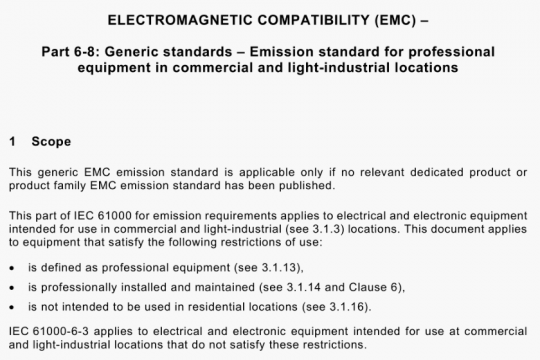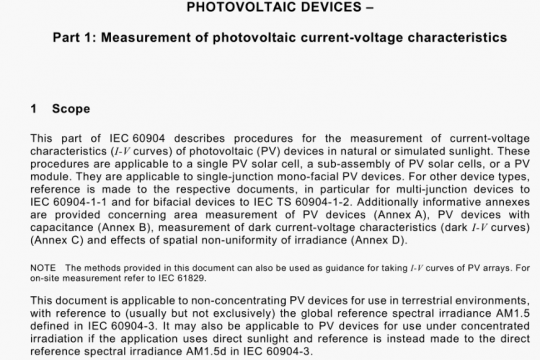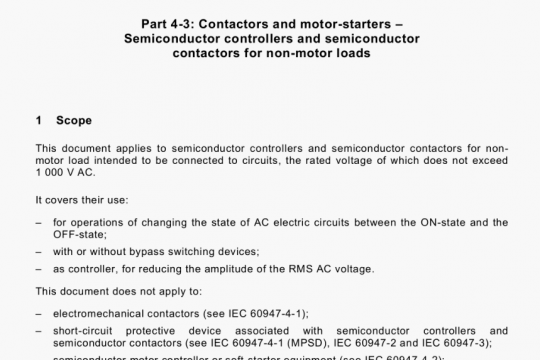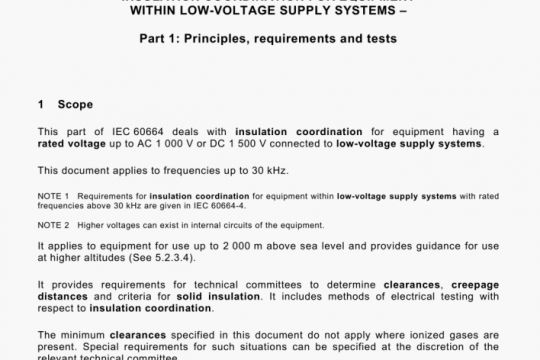IEC 60099-5-2018 pdf download
IEC 60099-5-2018 pdf download.Surge arresters – Part 5: Selection and application recommendations.
This part of IEC 60099 provides information, guidance, and recommendations for the selection and application of surge arresters to be used in three-phase systems with nominal voltages above 1 kV. It applies to gapless metal-oxide surge arresters as defined in IEC 60099-4. to surge arresters containing both series and parallel gapped structure — rated 52 kV and less as defined in IEC 60099-6 and metal-oxide surge arresters with external series gap for overhead transmission and distribution lines (EGLA) as defined in IEC 60099-8, In Annex J, some aspects regarding the old type of SiC gapped arresters are discussed.
Surge arrester residual voltage is a major parameter to which most users have paid a lot of attention to when selecting the type and rating. Typical maximum residual voltages are given in Annex F. It is likely, however, that for some systems, or in some countries, the requirements on system reliability and design are sufficiently uniform, so that the recommendations of the present standard may lead to the definition of narrow ranges of arresters. The user of surge arresters will, in that case, not be required to apply the whole process introduced here to any new installation and the selection of characteristics resulting from prior practice may be continued.
Annexes H and I present comparisons and calculations between old line discharge classification and new charge classification.
2 Normative references
The following documents are referred to in the text in such a way that some or all of their content constitutes requirements of this document. For dated references, only the edition cited applies. For undated references, the latest edition of the referenced document (including any amendments) applies.
IEC 60071-1:2006. insulation co-ordination — Part 1: Definitions, principles and rules IEC 60071-1:2006/AMD1:2010
IEC 60071-2:1996. Insulation co-ordination — Part 2: Application guide
IEC TR 60071-4, Insulation co-ordination — Part 4: Computational guide to insulation coordination and modelling of electrical networks
IEC 60099-4:2009, Surge arresters — Part 4: Metal-oxide surge arresters without gaps for a.c. systems
IEC 60099-4:20 14. Surge arresters — Part 4: Metal-oxide surge arresters without gaps for a.c. systems
3 Terms and definitions
For the purposes of this document, the following terms and definitions apply.
ISO and IEC maintain terminological databases for use in standardization at the following addresses:
• IEC Electropedia: available at http://www.electropedia.org!
• ISO Online browsing platform: available at http:Ilwww.iso.org/obp
NOTE These terms follow standard definitions as close as possible. but are not in all cases exact citations of
definitions In other IEC standards.
arrester — dead-front type, dead-front arrester
arrester assembled in a shielded housing providing system insulation and conductive earth shield, intended to be installed in an enclosure for the protection of underground and pad mounted distribution equipment and circuits
Note 1 to entry: Most dead-front arresters are load-break arresters.
Note 2 to entry: The use of dead-front arresters is common in the USA.
3.2 arrester disconnector
device for disconnecting an arrester from the system in the event of arrester failure, to prevent a persistent fault on the system and to give visible indication of the failed arrester
Note I to entry: Clearing of the fault current through the arrester during disconneclion generally is not a function of the device
3.3 arrester — liquid-immersed type
arrester designed to be immersed in an insulating liquid
3.4 arrester — separable type, separable arrester
arrester assembled in an Insulated or screened housing providing system insulation, intended to be installed in an enclosure for the protection of distribution equipment and systems
4 General principles for the application of surge arresters
The principle of insulation coordination for an electricity system is given in IEC 60071-1 and lEG 60071-2. Basically the insulation coordination process represents a risk management aiming to ensure the safe, reliable and economic design and operation of high voltage electricity networks and substations. The use of surge arresters helps to achieve a system and equipment insulation level while still maintaining an acceptable risk and the best economy of scale.
The introduction of analytical modelling and simulation of power system transients further optimise the equipment insulation level. The selection of surge arresters has become more and more important in the power system design and operation. It is worthwhile to note that the reliability of the power system and equipment is dependent on the safety margin adopted by the user in the design and selection of the equipment and surge arresters.
For Range I systems containing overhead lines, the main risk to equipment arises from induced and direct lightning strikes to the connected overhead lines. In cable systems not connected to overhead lines, overvoltages due to faults or switching operations are most likely to occur. In rare cases, however, lightning induced overvoltages may also be generated. In systems of Range II, in addition to Range I factors, switching overvoltages become important, increasing with higher system voltages. Overvoltages may cause flashovers and serious damage to the equipment and thereby jeopardize the supply of power to users. It is essential to prevent this by proper coordination of surge arresters with the insulation Therefore, it is recommended to use surge arresters if there are possibilities of lightning overvoltages or high switching overvoltages, which may be dangerous to the equipment.
The surge arresters should constitute a reliable part of the system. They are designed to withstand the voltages and the resulting currents through them with a sufficiently high reliability taking into account pollution and other site matters. In each system, such voltage stresses are (see IEC 60071-1):
— operating voltage;
— temporary overvoltages:
— slow-front overvoltages:
— fast-front overvoltages:
— very-fast-front (GIS applications)
where the slow-front overvoltages due to switching are of particular importance for arresters protecting Range II equipment.
As a general principle, the best protection of equipment and high surge arrester rated voltages are contradicting requirements. Thus the selection of an adequate arrester constitutes an optimization process, which has to consider a great number of system and equipment parameters. These are further explained in Clause 6, insulation coordination and surge arrester application.
5 Surge arrester fundamentals and applications Issues
5.1 Evolution of surge protection equipment
The metal-oxide (also called MO, or sometimes ZnO) surge arrester was introduced in the mid to late 1970s and proved to be a solution to the problems, which could not be solved with the gapped silicon carbide (SiC) arrester technology [191[201[2111. The protection level of a surge arrester was no longer a statistical parameter, but could be accurately given. The protective function was no longer dependant on the installation or vicinity to other apparatus — as compared to SiC arresters, where the sparkover voltage could be affected by surrounding electrical fields. The MO surge arrester could be designed to meet virtually any energy requirements by connecting MO resistor elements in parallel (even though the technique to ensure a sufficiently good current sharing, and thus energy sharing, between the columns is sophisticated). The possibility to design protective equipment that could handle extremely high-energy stresses also opened up new application areas, protection of series capacitors. for example, where the arrester is a huge arrester bank made of tens to hundreds of individual MO resistor columns connected in parallel.
Some of the first MO surge arresters utilised spark gaps in series with the varistor elements or in parallel with sections of the varistor column (shunt gaps). These designs reflected, to some extent, a concern about the long-term stability of the MO resistor material. Using spark gaps in series or parallel consequently made it possible to decrease the continuous voltage stress on the MO resistors and still maintain a low protection level. Another reason was to obtain protective levels better than for the most qualified SiC gapped arresters at that time with active spark gaps and low protection levels (18].
These designs are not found on the market any longer for HV applications. With experience. the elimination of gaps permitted the design of very compact, reliable, low profile arresters compared to what was possible with the former technology.
On the other hand, MO surge arresters with external series spark gap (externally gapped line arresters: EGLA) are still found on the market, with even increasing tendency. These arresters are used for protection of overhead transmission and distribution lines against lightning related fast-front overvoltages only. These arresters, therefore, are designed not to operate for slow-front and temporary overvoltages.
The MO resistor technology was developed further during the 1980s and 1990s through to the present day, towards uncritical aging behaviour, lower protection levels, higher permissible voltage stresses on the material, greater specific energy absorption capabilities and better current withstand strengths [1 9J(20J[22](23J[24][26J(27J[38](39][40J[55J(56J.
New polymeric materials, superseding the traditional porcelain housings, started to be used in the mid-1980s for distribution arresters. By the end of the 1980s, polymer-housed arresters were available up to 145 kV system voltages, and today polymer-housed arresters are accepted for all voltage ranges including 800 kV and the emerging UHV levels (1 100 kV, 1 200 kV) (21J(23J. Many of the early polymeric designs utilized EPDM rubber as an insulator material, but during the 1990s more and more manufacturers changed to silicone rubber (SIR), which has an outstanding performance under polluted conditions due to its hydrophobicity (ability to repel water), which is even transferred to pollution layers. SIR insulation is therefore considered less affected by environmental conditions, including IJV radiation and pollution.IEC 60099-5 pdf free download.




